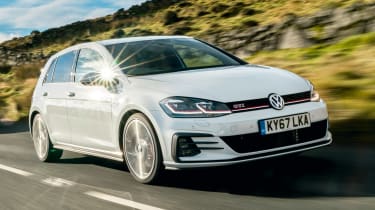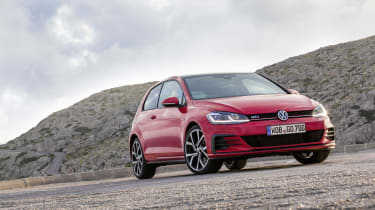Volkswagen Golf 7 GTI review (2012-2020) – ride and handling
British B-roads can be the making and undoing of a car. The GTI however is perfectly suited to them, with top-of-the-line chassis control and balance
If you’ve not driven a Golf GTI from the last five years, we’d suggest you do, as in its seventh generation the Golf’s ride and handling is its most impressive achievement. The MQB platform on which it is based is always a good start, but there is something transient in the Golf’s chassis specifically that makes it a more entertaining car to drive than other VW Group MQB-based models.
Compared to the standard hatch the GTI’s suspension is 15mm lower, and now features a standard electronically controlled front locking differential. The set-up is nothing like as stiff as some rivals, being firm, but incredibly well controlled, with impeccable wheel control and a fluid primary and secondary ride, even on the larger 19-inch wheel option.
The suspension itself is by MacPherson struts at the front and a multi-link set-up at the rear. Sometimes British B-roads can be the undoing of a car, and sometimes they can be the making of it. With the GTI it’s the latter. The bumps, humps and general rough and tumble of broken tarmac reveal just how talented the chassis is, as it tracks the road in a display of beautifully controlled damping.
The natural instinct is to put the car into its Sport setting and it certainly feels well resolved and not too harsh, which is impressive. However, if you go into the Driver Profile Selection screen and tap on the Individual setting then you can retain the Sport settings for steering, engine, ESP etc but knock the suspension back to Normal. Now you get a little more roll and a tiny bit of float over the bumps, which then lets you get the car moving around a touch more into and through corners, which is lovely. The balance remains neutral, but it’s so easy to place thanks to that stiff MQB platform that you can really throw it around.
More reviews
In-depth reviews
- Volkswagen Golf GTI 2025 review – the quintessential hot hatch improved but not perfected
- Volkswagen Golf R 2025 review – Mk8.5 not the return to form we'd hoped for
- Used VW Golf GTI (Mk7, 2013 - 2020) review – still the best hot hatch all-rounder
- Volkswagen Golf Mk8.5 2024 review – a return to form for the hatchback benchmark?
Reviews
It’s not as perversely oversteery as the previous-generation Focus ST, nor as front-led as the Peugeot 308 GTi, but finds a wonderful fluidity somewhere between them. Push really hard and the chassis responds. Want to adjust your line mid-corner? No problem. What about a touch of oversteer? Easy. It’s as compellingly pliable as the very best, even if it lacks the outright capability of the Honda Civic Type R or agility of the Renault Mégane RS.
evo Tip
We reckon it’s worth going for the optional Adaptive Chassis Control which, in Sport, means stiffer damping, heavier steering, better throttle response and looser ESP. It might just be the ideal setting for track days. The chassis tenses noticeably and through, say, a fast chicane, the GTI remains flat and agile.
evo Comment
‘The main issue is the GTI’s ability to excite. The most engaging front-wheel-drive hot hatches take a while to key into. After a couple of hours on the road it sometimes feels as if the GTI had yielded all of its character. But the GTI is now in its seventh iteration and 37th year and we’d wager no other car of its genre has ever benefitted from more engineering man-hours, development miles or intellectual effort.' David Vivian, Contributing Road Tester
You can read a more thorough assessment of the GTI Clubsport here, but suffice to say it's the best driver's car in the Golf range.




